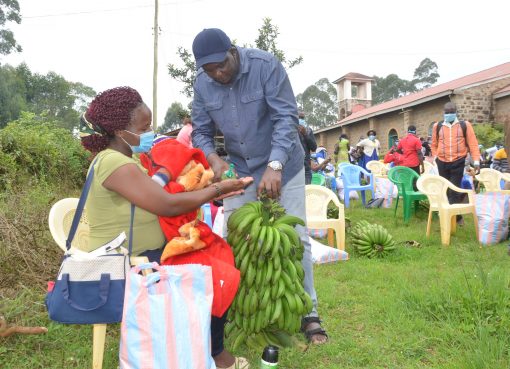Most countries, especially in Sub-Saharan Africa have not yet fully exploited the potential of Root and Tuber crops in the contribution to people diets, livelihoods and economies.
Agriculture Research Secretary at the Ministry of Agriculture and Livestock Development, Dr. Oscar Magenya, said that in Kenya, market demand for the roots and tubers is expected to continue growing, driven partly by rapid urbanization and changing dietary habits of the growing town populations.
Speaking during the 19th International Triennial Symposium of the International Society for Tropical Root Crops (ISTRC), Dr. Magenya added that Roots and Tubers have made a steady transition from the perception as a low-income food option a few decades ago to becoming part of the mainstream dietary choices, even for the upper and the growing middle class.
The production of main root crops such as Cassava, Sweet Potato, Coco Yam, and Yams remains below potential and the status therefore presents a challenge to policymakers, researchers, and other value chain actors to strengthen the Roots and Tubers Value chains in order to increase their competitiveness in our agri-food systems.
To achieve this, the Research Secretary noted the need to undertake several initiatives including supporting smallholder farmers in this Sub-sector to commercialize the production of the Root and Tuber crops.
The Government, he said recognizes the challenges in the Sub-sector and has laid out a clear roadmap for sustainable growth and development of a vibrant Root and Tuber crops subsector as set out in the National Root and Tuber Crops Development Strategy 2019-2022.
The strategy is part of the greater Kenya Vision 2030 development blueprint, where the role of agriculture as a pillar of the economy is well articulated and in the current Agricultural Sector Transformation and Growth Strategy 2019-2029.
“The National Root and Tuber Crops Strategy aims at advancing the development of the root and tuber crops in Kenya from an initial focus on high-yielding varieties and pests and diseases tolerance to include a wider range of other intervention areas that are essential to the sub-sector,” he said.
Dr. Magenya said the symposium will not only address opportunities that biotechnology techniques can offer for improving the quality of these crops including molecular tools, transgenic, and genome editing, but also additional tools placed in the farmer’s hands to improve production and quality of root and tube crops.
“The governments seek to confront the perennial food and nutrition insecurity challenges, thus competitiveness and viability of Roots & Tubers value chains will depend on improvements on inclusive business models, sustainable intensification of production, and the strengthening of the capacity of Small and Medium Enterprises (SME) and farmer organizations.
President of the International Society for Tropical Root Crops (ISTRC), Prof. Lateef Sanni, said the threats to food system, which have made it difficult for innovations to reach farmers hands and the shocks brought about by the Ukraine war have brought to the front burner the importance and significance of root and tuber crops.
“Empirical data shows that root and tuber crops are the most important commodities for food security nutrition and income generation, particularly among small holder farmers. As resilient crops, roots and tubers might assist farmers in adapting to climate change and fluctuation.
Kenya Agricultural Livestock Research Organization (KALRO) Director General, Dr. Eliud Kireger, said that roots and tuber crops are sources of income for our farmers and are climate resilient and above all, they provide carbohydrates, minerals, vitamins, and raw materials for industrial food processing and blending.
Dr. Kireger in a speech read on his behalf by KALRO Director Crops Research Systems, Dr. Lusike Wasilwa said that KALRO in collaboration with partners have developed and released over 19 varieties of cassava including KMEs, Tajirika, Karembo, and Karibuni, over 50 potato varieties namely Unica, Shangi, Sherekea and Asante and over 24 varieties of sweet potatoes such as Kenspots, SPKs, Kemb10, Mugande, Vitaa and Kabonde.
“Enhanced production of roots and tuber crops, is expected to make a huge contribution to our economy, and to the achievement of Vision 2030 and we believe that the technologies, innovations and management practices on root and tuber crops that will be shared and partnerships and linkages that will be created through this forum will help boost food and nutritional security for all our people,” said the Director General.
In Kenya, cassava, potato, sweet potato crops are cultivated in about 61,000, 18, 5000 and 6,000 hectares respectively.
The estimated per capita consumption of cassava, potato, and sweet potato is 20kgs, 33kgs and 18 kgs, respectively and based on the current population of 54 million, the country requirement is 1.1Million MT, 1.8 million MT and 1million MT respectively, while the annual production is estimated as 0.82 million MT, 1.7 million MT and 0.81 Million MT respectively.
This indicates a national demand deficit for cassava, potato, and sweet potato of 0.25 Million MT, 0.08 Million MT and 0.16 Million MT respectively.
The one-week symposium that will run until Friday 25th is running under the theme, “Technological innovations for strengthening Root and Tuber crops for resilient food, nutrition and industrial systems towards sustainable economic development.
By Wangari Ndirangu





